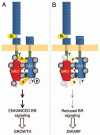Functional importance of BAK1 tyrosine phosphorylation in vivo
- PMID: 21350342
- PMCID: PMC3142422
- DOI: 10.4161/psb.6.3.14337
Functional importance of BAK1 tyrosine phosphorylation in vivo
Retraction in
-
Editorial retraction.Plant Signal Behav. 2016 Aug 2;11(8):e1211452. doi: 10.1080/15592324.2016.1211452. Plant Signal Behav. 2016. PMID: 27603314 Free PMC article. No abstract available.
Abstract
The plant receptor kinase BRI1-ASSOCIATED RECEPTOR KINASE 1 (BAK1) is known as a partner of several ligand-binding leucine-rich repeat receptor kinases, including BRASSINOSTEROID INSENSITIVE 1 (BRI1) and the flagellin receptor FLS2. Autophosphorylation of receptor kinases is recognized to be an important process in receptor kinase signaling, and at least with the recombinant protein, BAK1 was shown to autophosphorylate on Tyr residues in addition to numerous Ser/Thr residues documented previously. We recently identified Tyr-610 in the carboxy-terminal domain of BAK1 as a major site of autophosphorylation and showed that phosphorylation of this residue is essential for at least some functions of BAK1 in vivo. In particular, the function of BAK1 as co-receptor with BRI1 in brassinosteroid (BR) signaling is impaired in transgenic plants expressing the BAK1(Y610F)-Flag directed mutant. Recombinant cytoplasmic domains of BRI1 and BAK1 interact and transphosphorylate each other in vitro in a manner that mimics their interaction in vivo; while BAK1(Y610F) binds normally to BRI1 its ability to transphosphorylate and activate the kinase domain of BRI1 is severely compromised. To further elaborate on this earlier model, we present additional results showing that the interaction between BAK1 and BRI1 in vitro is Mg(2+) dependent, suggesting that cytosolic [Mg(2+)] may play some role in receptor kinase signaling in vivo. We also compare the primary structures of BRI1 and BAK1 in terms of the occurrence of Tyr residues in the cytoplasmic domain, and identify differences in which residues are essential for kinase activity. Finally, transgenic plants expressing the BAK1(Y610F) directed mutant have alterations in the transcriptome that extend beyond the genes that are BR regulated in nontransgenic plants. In particular, the basal expression of many defense genes is significantly reduced in Y610F plants, which is consistent with the earlier report in reference 4, that BAK1 controls the expression of a number of genes associated with microbial infection. The present results establish a site-specific role for Tyr phosphorylation of BAK1 in BR signaling and regulation of plant defense mechanisms, which may have implications for enhancing agricultural productivity.
Figures





References
-
- Wang X, Kota U, He K, Blackburn K, Li J, Goshe MB, et al. Sequential transphosphorylation of the BRI1/BAK1 receptor kinase complex impacts early events in brassinosteroid signaling. Dev Cell. 2008;15:220–235. - PubMed
-
- Kemmerling B, Schwedt A, Rodriguez P, Mazzotta S, Frank M, Qamar SA, et al. The BRI1-associated kinase 1, BAK1, has a brassinolide-independent role in plant cell-death control. Curr Biol. 2007;17:1116–1122. - PubMed
Publication types
MeSH terms
Substances
LinkOut - more resources
Full Text Sources
Molecular Biology Databases
